Servals, dogs, vultures and cheetah
Day 5 - Servals, dogs and vultures
Pack WD2 hadn’t been seen for a week, we needed to get visuals; check their health, check for snares; the ramps were ready, the path set. We began our mighty trip south at 3:30am under clear skies, the last vestiges of the milky way lighting our way, a slithery crescent moon setting on the horizon, we drove towards the southern cross.
From the ramp we took the management track, the beginning of the “long way south”. It’s a slow and bumpy road which eventually stops at a dead end. Tree branches are low, acacia spikes risk catching you in the face, “heads” shouted every few seconds, head lamps lighting up the route, truck swinging left, then right, we grab on tight.
When is a serval not a serval?
“Stop! Serval!”, PJ didn’t see it. A yellow spotted cat like creature climbing a tree besides us. We reversed. “Where?” It had gone. “You saw a serval?”, PJ exclaims, both in disbelief and frustration that he’d missed it. “Are you sure?”, Kelly begins taking the GPS point for the sighting, we flick through the mammal book looking for what we’d seen. “Oh, it was a genet, a large spotted genet” – “We get those at camp”, PJ replies, already shifting the truck into gear and driving away. Team Africa has its mascot; a genet cum serval, proudly serving, wildlife servailance, et al. From now on everything is a serval.
Finding all the dogs
At the road’s dead end I stand on the truck, darkness still surrounding us, scanning for a signal. WD6 pack has three collars; Dumela the alpha male – his stopped working, Thandezile (Zile to her friends), the 8 year old alpha female (a legendary dog), and Fezo, her daughter. I scanned for Zile and Fezo, trying desperately to get any kind of signal, a vague beep comes through the static. Then a howling angry grunt from the darkness, we don’t stick around to find out what it is. You wouldn’t want to bump a black rhino or an elephant in this tight space. And the elephants were down here somewhere.
We go off road. From the track PJ carves his way through gaps in the thicket, driving around thorny trees, following old game trails, threading a way through in the dark, until we reach another management track. A crossing made, it brings us out on the far side of the pan, a green and luscious place, the air smelling of fragrant potato bush. Zebra, wildebeest and nyala graze in the early morning mists.
The road takes us to the fence line where we cross over into Phinda, taking their border road to Mkhuze’s southern gate. We stop to scan, and from the top of the truck I’m treated to a spectacular view; the morning sun is just about to come up, there’s mist in the valleys, and the hilltops resemble an oil painting; a stork flies past, perfecting my mind’s picture. All this while scanning for Zile.
Inside Mkhuze, besides the hunting lodge, we get a strong signal, Zile at 9 o’clock, we zoom into the hills, it’s imperative we get a visual. I scan as we drive, tweaking gain, watching bars, rotating the antenna, arms aching. 7 bars, maximum, she’s in front, no behind, we’ve past her, reverse, turn, try again, 7 bars. There, in front, an impala runs, chased by a single dog. They’re all here somewhere. I scan again for Fezo and Zile, or “Filo”, the pastry dogs, as I keep miscalling them. Now they’re on the road; 1, 2, 3, 4 – we snap photos for ID. This pack is 12 strong, still 8 to find. They disappear, they move away from us, the beep slows down, they’re resting.
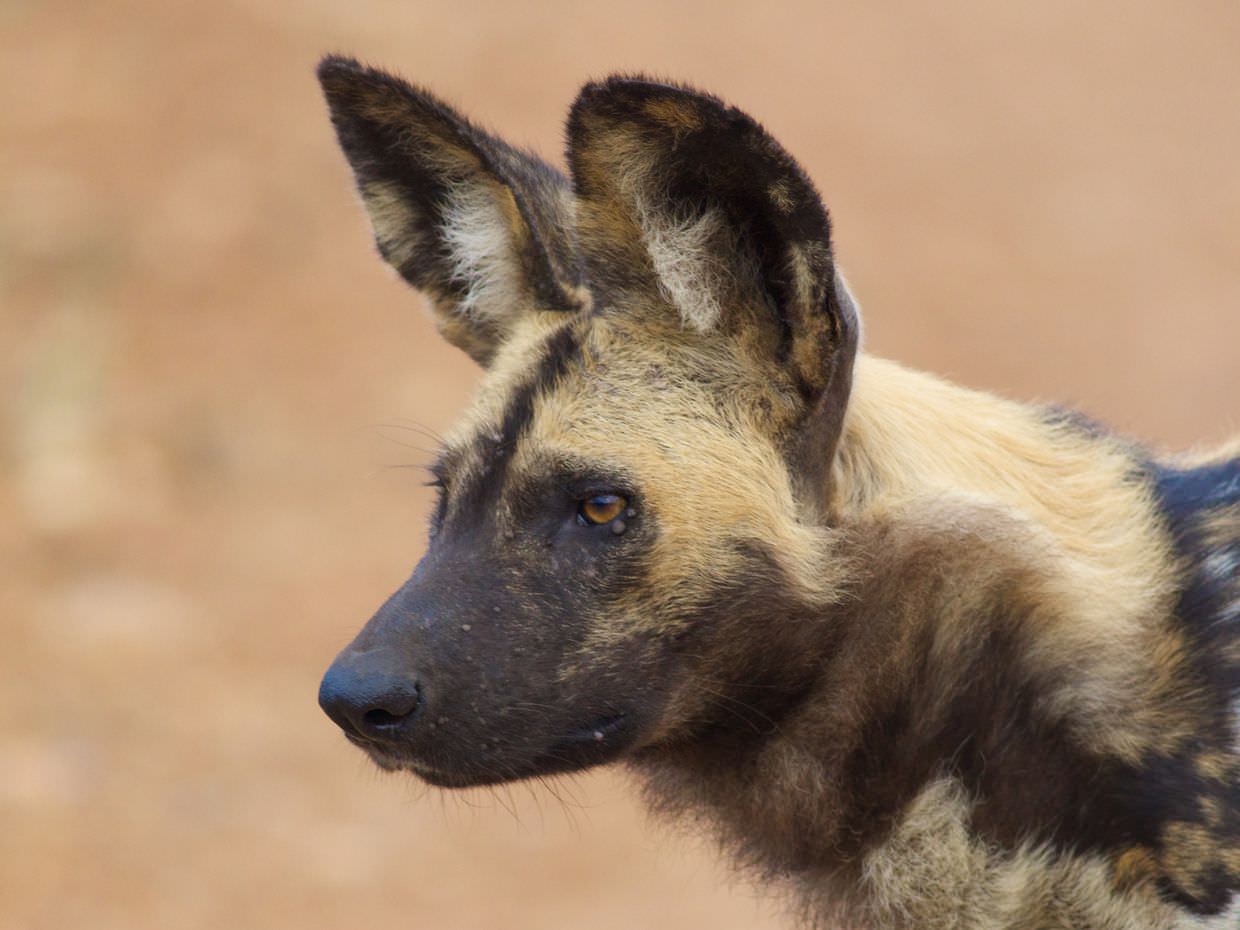

Not satisfied, PJ brings us down the hill and out towards the dam. We’ll find them all. From a snaking management trail we go off road again, weaving through green fever trees, narrowing down the signal. A single dog sees us and runs, a scout? A guard? Are we near a den site? The signal is resting again.
Time for coffee? We unpack the cooler box and prep the cups, but the dogs catch us off-guard, they re-appear and we need to move again, driving back towards the main road, scanning as we go; all this without caffeine. We stop on the gravel path, the main road stretching out in front of us. Did we lose them? We sit and wait, perhaps it’s time to go?
Puppies!
Out of nowhere, to our right, a dog appears, shortly followed by another and another. Then puppies. The entire pack begins to emerge onto the road in front, 3 adults, 4 adults, 2 puppies, 4 puppies … they begin to trot up the road, yet the pack keeps coming, more and more puppies, cute little creatures bouncing with the adults, following them, playing, running into each other, 6, 7, now 10 puppies, even more, 14 puppies, stretched out across the road, their fluffy white tails bouncing as they run. The remaining adults following up from behind, the whole contingent, all 12 adults and 14 puppies! The most phenomenal sighting. 26 healthy wild dogs. PJ has an ear to ear grin.
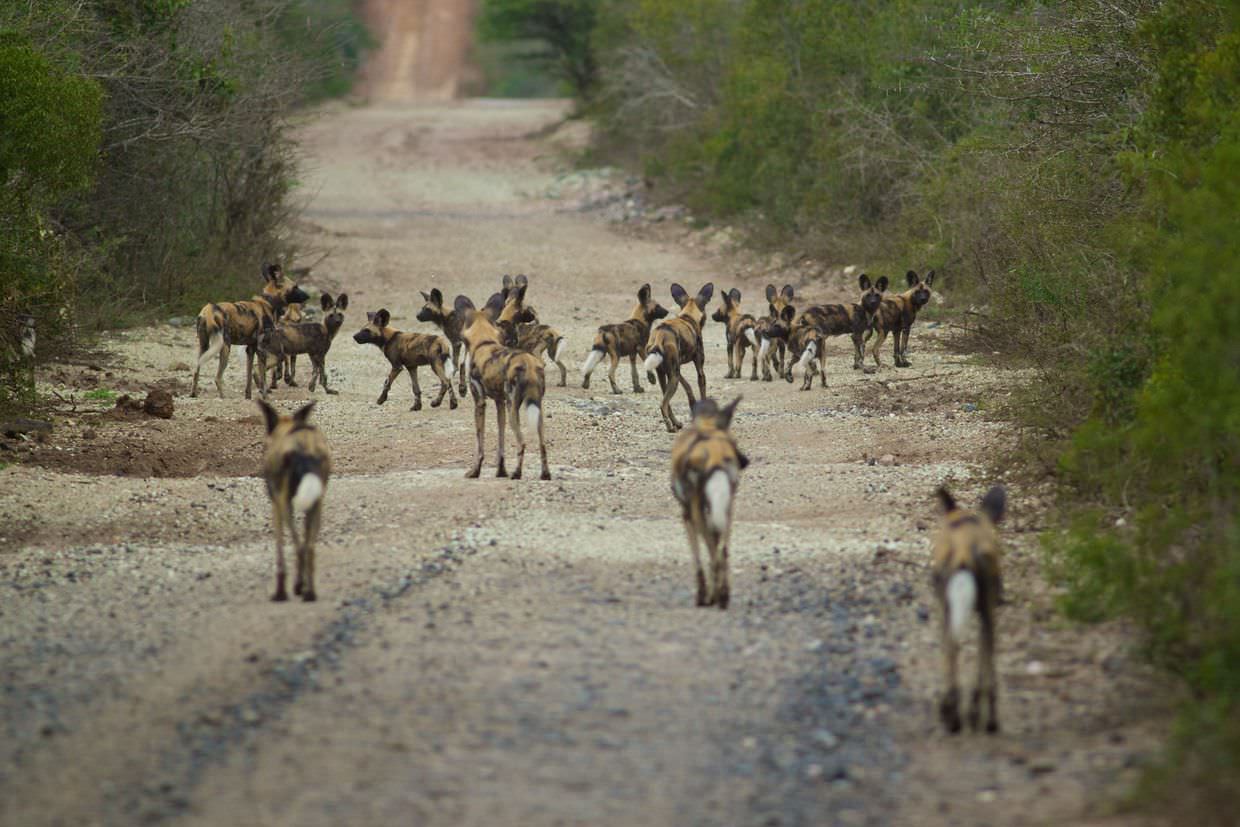
Naming them is like trying to name the dwarves; there’s Zile, Dumela, and Fezo and Fanakalo, then Gert, Gatiep, Gompie (with his floppy ear), Genis, Gagina, Getruida, Gloudina and Griet. Each year they’re named with the next letter; all the _G_’s are yearlings. Any surviving puppies will have names beginning with H, the puppies are 4 months old, they look healthy, but there’s still a long way to adulthood in the bush.
We follow the dogs up the road, not getting too close, they turn into the bush and we follow along the nearest track. We find them resting by a waterhole; adults drinking, puppies playing, a panorama would have captured this magical scene perfectly. All the pups are nervous of us, they run away, then come back, run away and back again, so cute. Eventually the pack moves off, we lose sight once more.
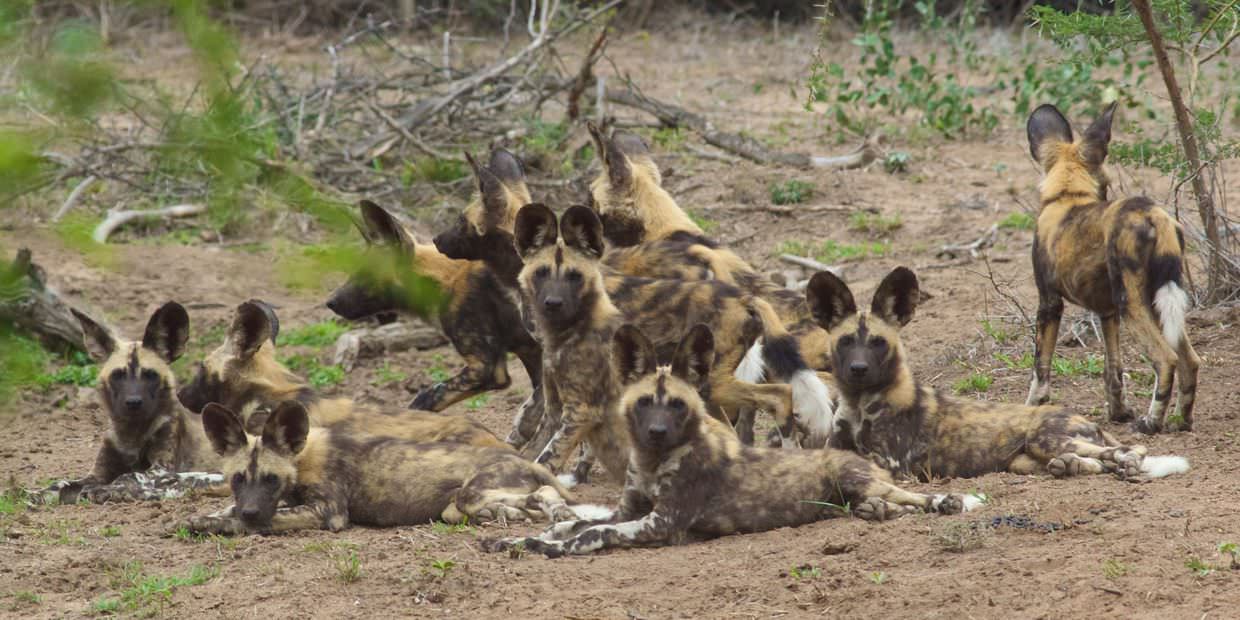
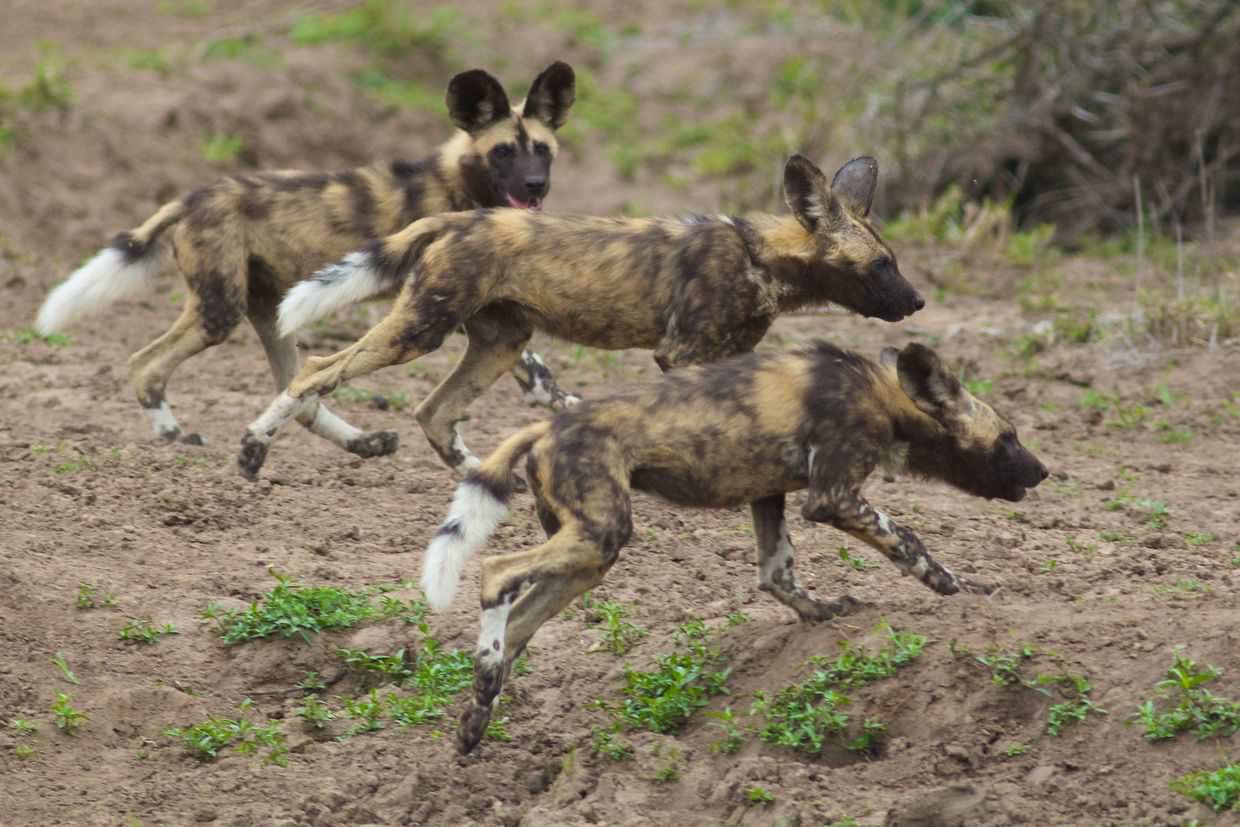
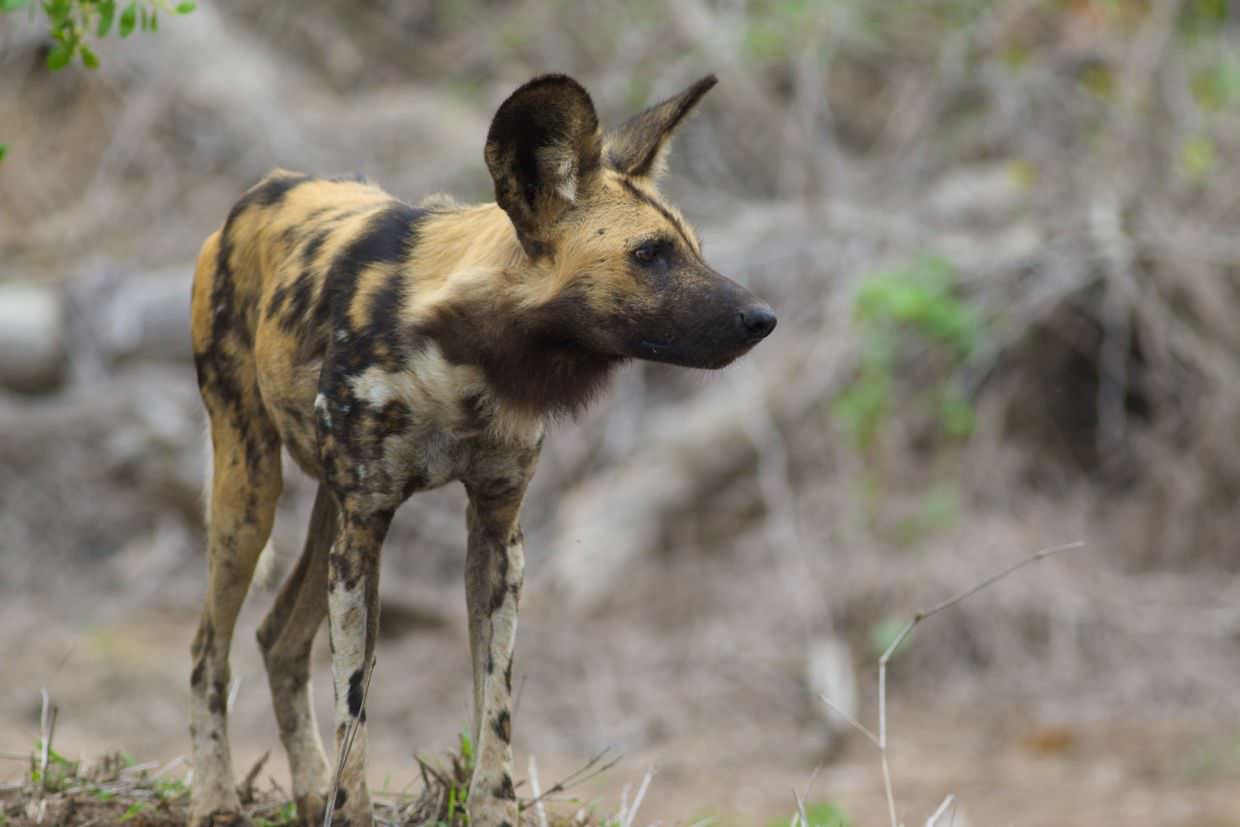
It’s time to go, we need to scan for lions and retrieve camera traps. We wait for a resting signal to make one last triangulation, a breather to take in what we’ve seen. And the dogs had one last surprise for us. While sitting quietly we hear a rustle in the bushes, movement, a male nyala sprints across in front of our parked truck, shortly followed by two chasing dogs. These dogs are really spoiling us.
Our spirits were dampened slightly when we discovered lions MLF2 and MLF3, two particularly vicious females, were nearby. We triangulated their position and asked them politely not to go towards the dogs. After grabbing the SD cards from the camera traps it was time to head back north, with speed.
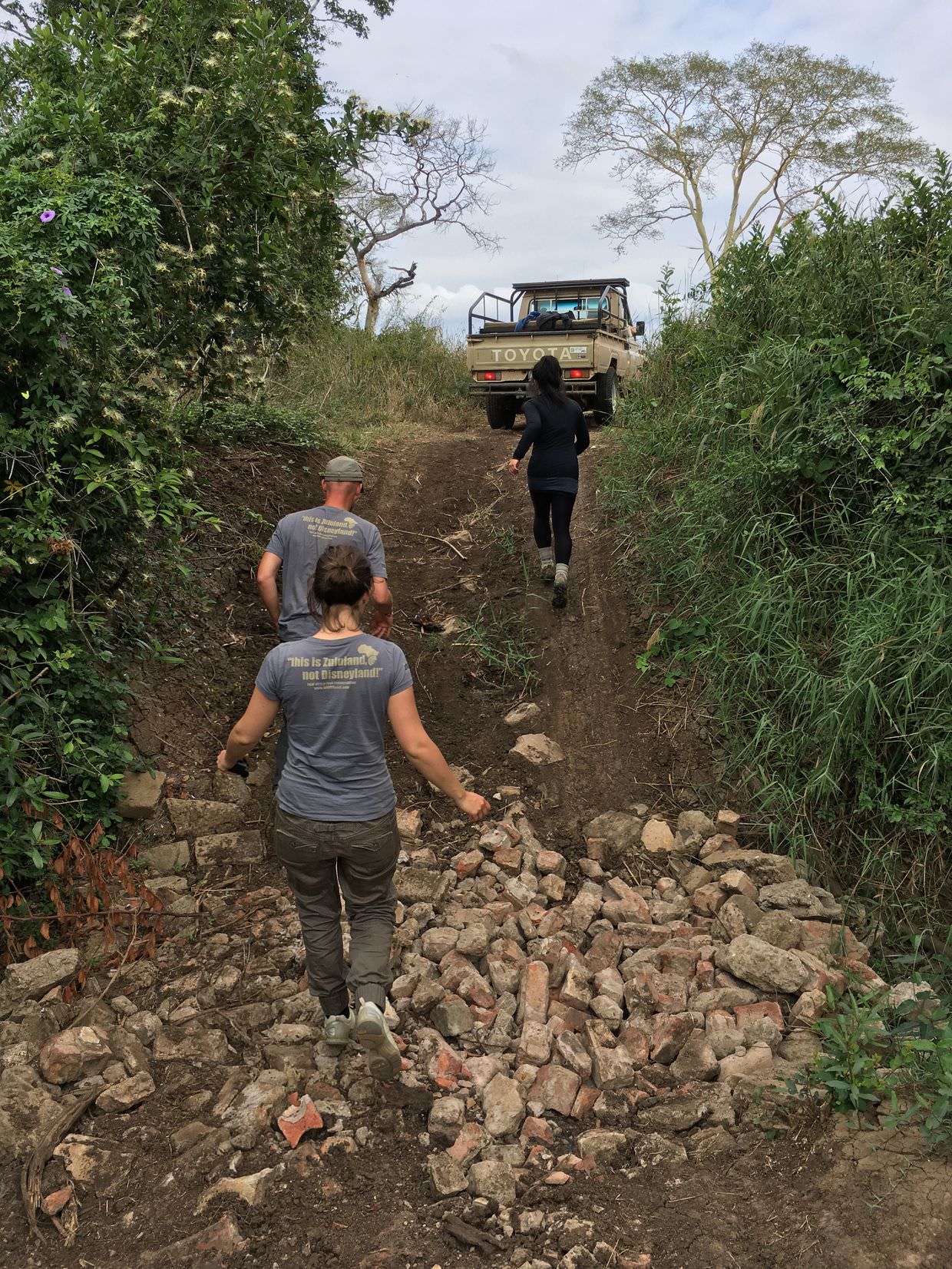
Tagging vultures
Chris Kelly, co-founder and director of Wildlife Act, monitor of monitors Cole, and volunteer Brendan, were up north working to ring and tag vultures. We needed to get north quickly if we wanted to observe. Back along the border fence, past the pan, through the off-road thicket, along the management track, over the temporary ramps we’d built; PJ drove quickly and perfectly to get us back in time. We meet Cole on the road and follow him to the next vulture nest site.
Each year, for one week, there’s an initiative to ring and tag vulture chicks. Nests near the road are marked, and using a GoPro with the longest selfie stick you’ll ever see, they are checked for suitable chicks. To be tagged they must be old enough and big enough, if they’re large enough they might also be fitted with a solar panelled GPS tracker. If the chicks are suitable a cherry-picker is brought in alongside the nest, the chick is retrieved and brought down – its bill, head, wing, tarsis, vent and cloaca are measured, blood is taken from its leg, a yellow triangular tag is attached to the top of each wing and a ring to a leg.
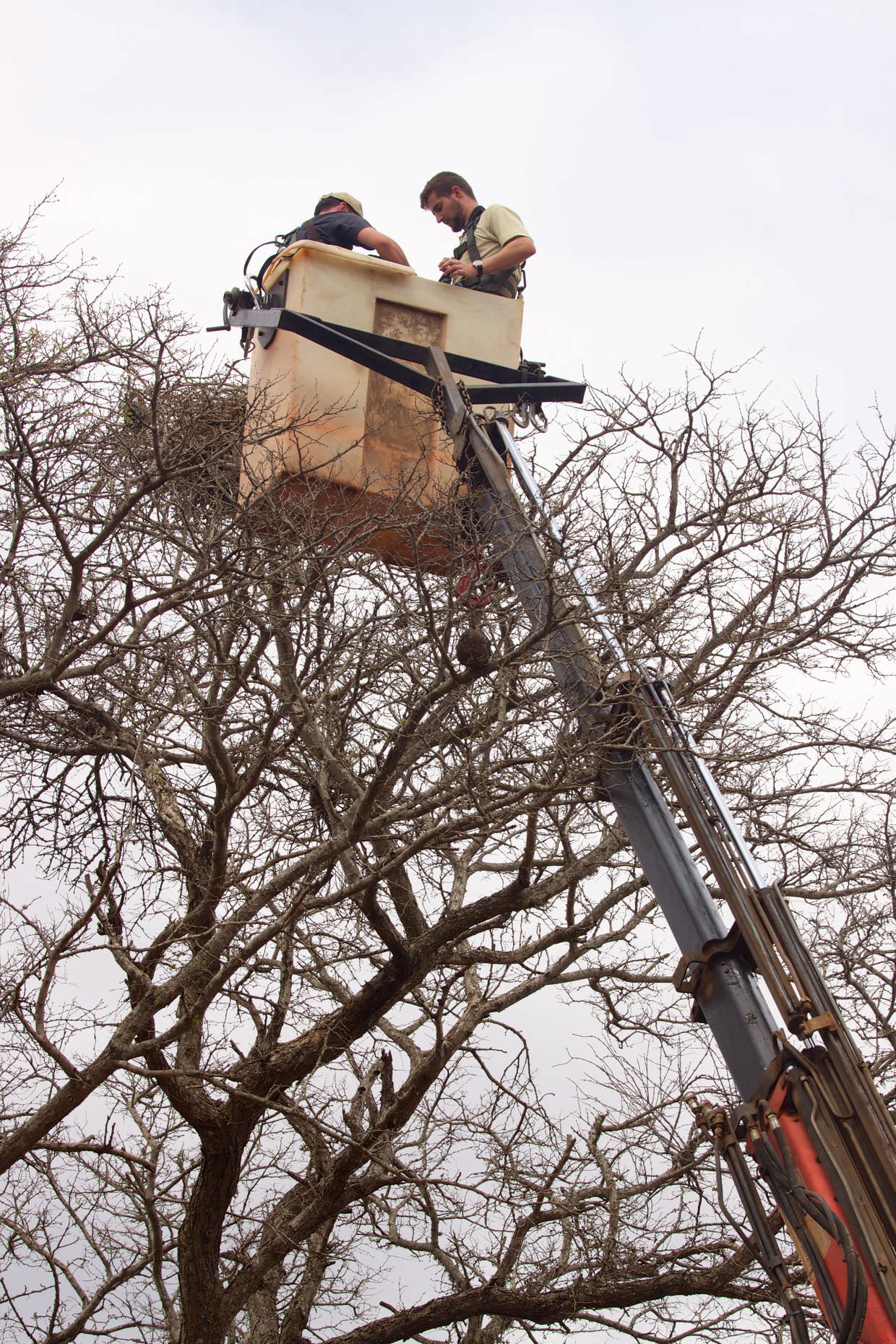
“Don’t shake my hand, I’m covered in vulture vomit”, Cole greets us when we get out. The chick has one defence mechanism – if a predator approaches it will vomit over 1kg of stomach contents over it; consider the food the vultures eat – decaying dead meat, along with the bacteria living inside a vulture, and you’ll understand why that’s a potent weapon; if any of that gets in your mouth you’ll end up in ICU for a few days. Brendan says hey, he’s been travelling with Cole and Chris all week, working on vulture conservation after raising funds back home.
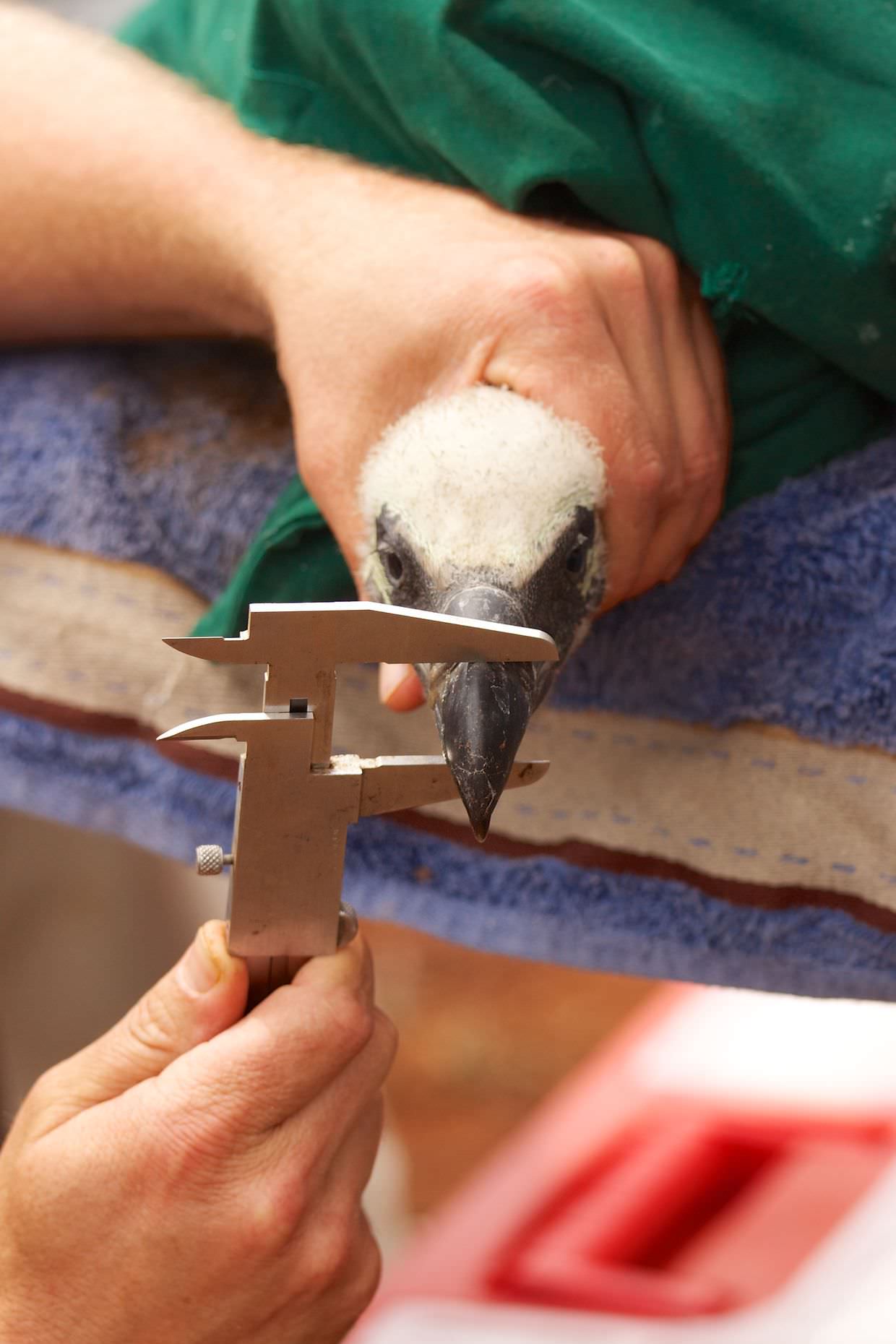
By now it was midday, the sun was hot and there was little shade. After 10 hours on the truck, and without any coffee, this last bit was tiring, but entirely worth it. We watched as PJ and Cole rode the cherry-picker up to the nest and retrieved a 6 week old white-backed vulture chick, covering its eyes to keep it calm. From the picker they brought it to a desk with scales and tools for the job, where the experts waited – serious and focussed (before they’d been saving feathers and writing GPS co-ords on them). While the experts worked I had the delicate job of holding down the vulture’s head; arching my hand over its neck, lightly, avoiding pinching. This vulture chick is M047. And when all was done, Charlotte nervously carried the chick back to the picker, so delicate, so anxious; so happy afterwards. In total they tagged 3 vultures, there were other nests but some weren’t accessible, others were empty or the chicks were too young.
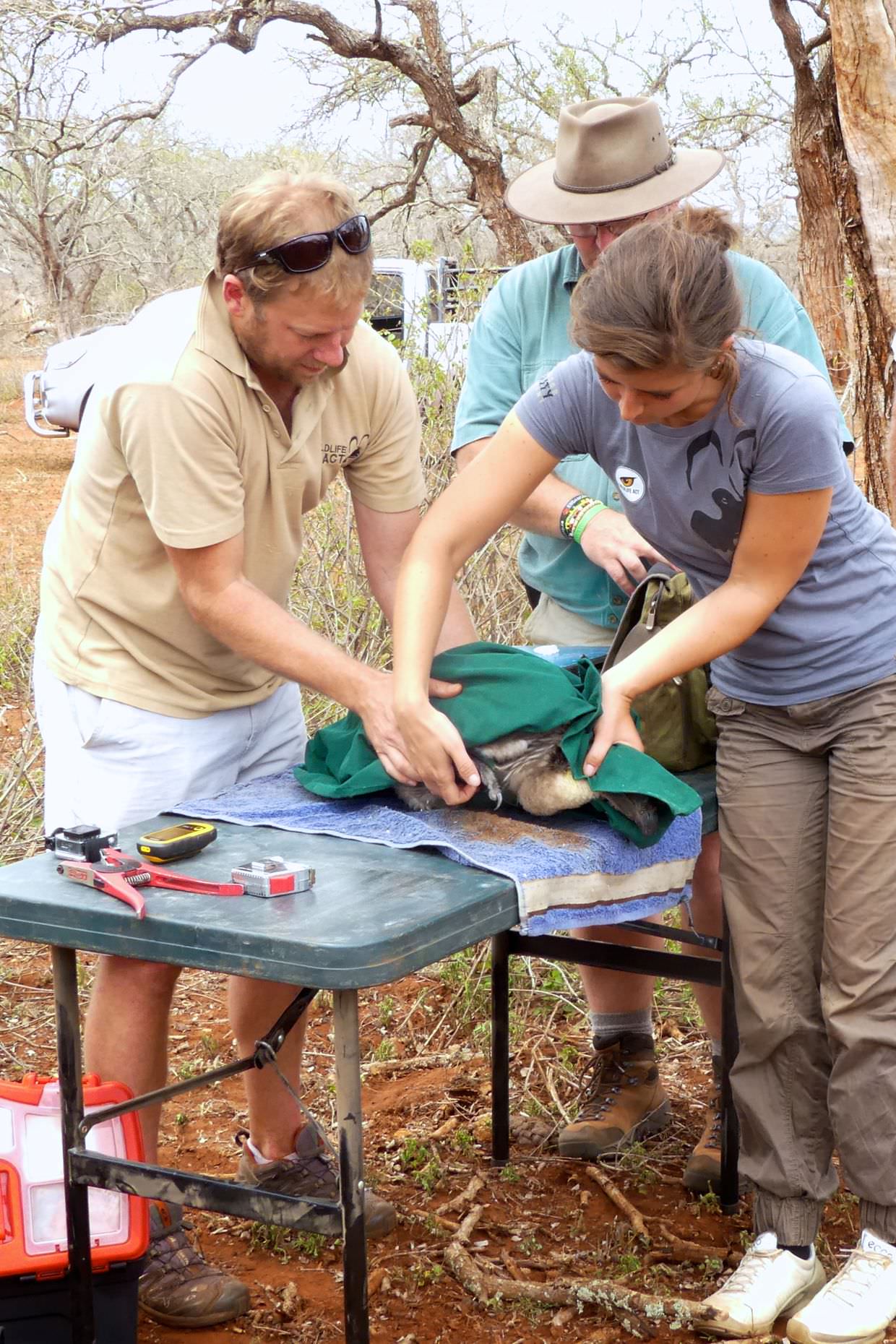
Cheetah at night
Now, even after this marathon session, the work in Mkhuze does not end. We were out again at 4pm, searching for MCM17 and MCM18. By now it was overcast, there might even be storms. The stormy skies played havoc with our tools, we struggled to get signal from the beacon, or the quarry; we took a turn up the mountainside, a wrong turn, they weren’t here.
It was Kelly’s turn on the telemetry in these difficult conditions, but she found a signal and pointed us in a new direction. “Lots of petrol for this”, PJ warns, but it was worth it. We follow a new road, new even to PJ, which brought us past green foliage and luscious vegetation, a drainage line, out to the reserve’s edge. Kelly scans again, and there they were, our two male cheetah sitting beneath a tree.
They’re sleeping, stomachs swollen after a recent feed. We need to stay near to them for 20 minutes for the collar data to download to our relay device. They don’t make this easy; rising from their slumber they walk around, roll around, scent mark a tree, take a shit, a real show. We stay as long as we can, until it’s dark.
On the drive home lightning illuminates the sky.
We ate chakalaka and beans with rice.
Day 6 - When shit hits the wheel
On a warm overcast morning we left in search of WD6, our first session with new Team Africa member, Brendan. Goodbye scorpion Brandon, wherever he’d gone. Joris guided us with his telemetry skills. The signal brought us into an area of impenetrable thicket, the dogs were here somewhere, somewhere in this block, but finding them was like spotting a gorgeous bush-shrike, nigh impossible in this stuff. Even when you know they’re there.
It was while zipping up and down these little roads that I noticed something sticky in my hair. I went to brush my hair with my hand and found a thick brown substance on my fingers, I raised it to my nose, expecting mud, I gagged. What is this shit? Vulture shit? I looked all around me for other signs of splatter. “I think a bird shat on me”, Brendan tells me that’s good luck. With anti-bacterial wet wipes I clean my hair, Charlotte too had some on her cheek. We cleaned and cleaned, but each time we stopped the smell was still with us. Where is this shit? We checked everywhere, our clothes, our hair, our bags. I looked out over the edge of the pickup, there it was, a splatter of brown shit streaking up from the wheel, across the door panel towards us. PJ must have driven through this fresh shit, it caught the wheel and was flung at us with gusto. Hitting the fan, as it were. Based on the smell and the proximity of dogs, we also ID’d the shit as being wild dog shit; the stinkiest grossest shit imaginable. What elite club I am in, how many people can say they’ve had the shit of a critically endangered wild dog in their hair, eh? “There’s no good luck if it’s wild dog shit”.
As if they could smell us, the dogs appeared. Ezweni and the two Madikwe males; Ezweni leading the way, the boma-fied males taking her lead. These two males, formerly three until a horrible snare death, are from Madikwe, and while they were being moved lived for a long time in a boma, where they were fed. They lost some of their street skills, and weren’t so good in the bush after that. It’s lucky they have Ezweni to lookout for them, she dispersed from WD6 and bonded with the new group, creating this pack. Looking closely we can see recent wounds on the males from sparring with a hyena, puncture wounds, Ezweni knows not to mess with a hyena. Equally, when feeding, the males will go straight in to eat, while the experienced female knows to keep a lookout. She’s schooling them. One of them rolls around in a fresh rhino midden; perhaps my experience with shit could have helped me bond with them too.
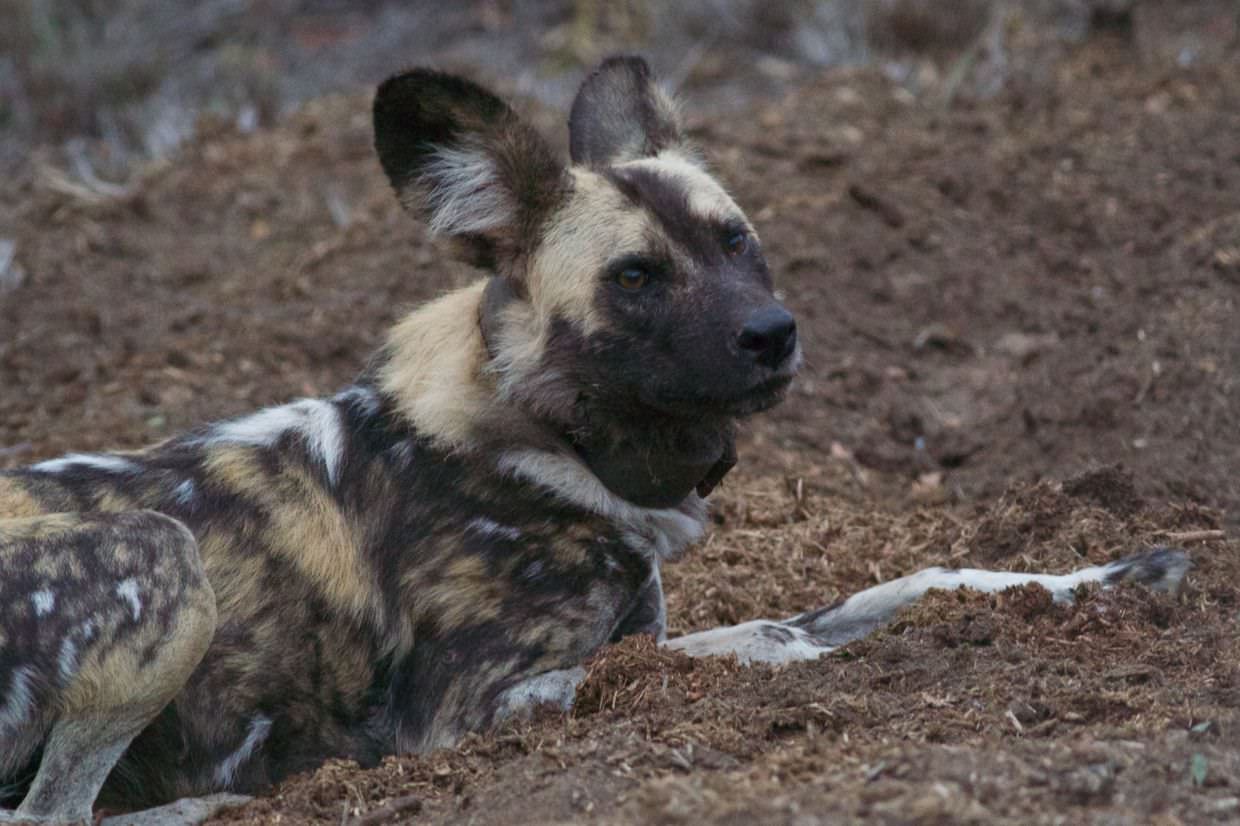
On the road back we follow hippo tracks, from some muddy patch out to the pan. And beside the beacon we stop to download lion collar data. Nearby 11 white-backed vultures fly over, they’ve been eating the bait put out for them, part of a “vulture restaurant” conservation strategy – bait them, get as many in as you can, then look for tags, etc. Though when the bait was put out yesterday none arrived.
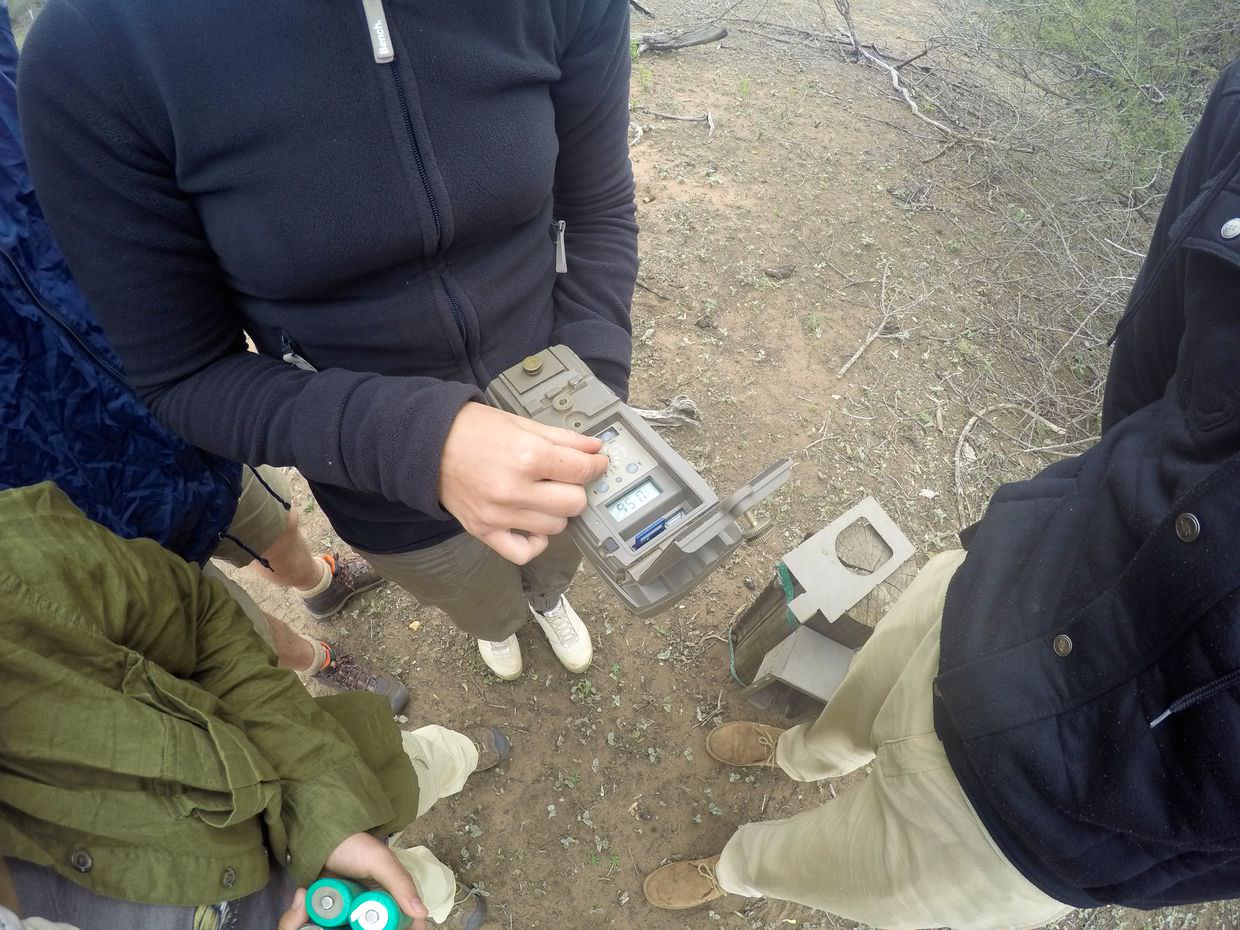
Yellow shapes on the horizon
We hadn’t spotted the lions in a while, we wanted to get new visuals on our afternoon session. Our signals had told us that MLF4 had left MLF5, perhaps she was denning and the cubs had arrived. We triangulate her signal to some impossible to reach hillside and strain with our binoculars to see her. I pick out a yellow blur beneath a tree, in my photos it’s clearly moved, I’ll conclude that it was MLF4, but PJ thought otherwise, “rocks”. These debates were the highlight of our dark and gloomy evening.